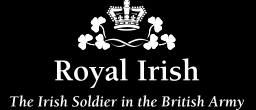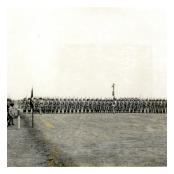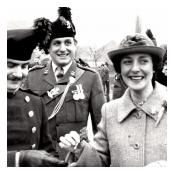Saint Patrick’s Day and the Sprig of Shamrock
(Below right, the 2nd Battalion the Royal Inniskilling Fusiliers in the Anzio beachhead receive a rum ration to celebrate St Patrick's Day 1944 (© Copyright IWM 13057).)
 On 19 February 1900, Queen Victoria received a fourteen-year old bugler from The Royal Dublin Fusiliers. His name was James Dunne and he had been wounded in the arm and chest at Colenso on 15 December 1899, where he had also lost his bugle in the Tugela river. Victoria thought he was ‘a nice-looking modest boy’ and presented him with a new and inscribed bugle. Shortly after her encounter with Private Dunne, and following news of the bloody battles and heavy losses in the fighting to relieve the Boer siege of Ladysmith, Victoria's heartfelt reaction, dated 28 February 1900, was telegraphed to General Sir Redvers Buller. It was published in Natal Army Orders on 5 March 1900 - less the words 'my sympathy and':
On 19 February 1900, Queen Victoria received a fourteen-year old bugler from The Royal Dublin Fusiliers. His name was James Dunne and he had been wounded in the arm and chest at Colenso on 15 December 1899, where he had also lost his bugle in the Tugela river. Victoria thought he was ‘a nice-looking modest boy’ and presented him with a new and inscribed bugle. Shortly after her encounter with Private Dunne, and following news of the bloody battles and heavy losses in the fighting to relieve the Boer siege of Ladysmith, Victoria's heartfelt reaction, dated 28 February 1900, was telegraphed to General Sir Redvers Buller. It was published in Natal Army Orders on 5 March 1900 - less the words 'my sympathy and':
'I have heard with the deepest concern of the heavy losses sustained by my brave Irish soldiers. I desire to express my sympathy and my admiration of the splendid fighting qualities which they have exhibited throughout these trying operations. R.V.I.'
 On 14 March 1900, Natal Army Orders promulgated an instruction stating:
On 14 March 1900, Natal Army Orders promulgated an instruction stating:
‘Her Majesty the Queen is pleased to order that in future on Saint Patrick’s Day all ranks in Her Majesty's Irish regiments shall wear as a distinction a sprig of shamrock in their head-dress to commemorate the gallantry of Her Irish soldiers during the recent battles in South Africa.’
This meant that 17 March 1900 was the first opportunity for Irish soldiers to wear their shamrock (seamróg*) with pride, as prior to this date the Wearin' of the Green had been banned. She also directed that an Irish regiment of Foot Guards be raised and the 1st Battalion The Irish Guards was formed on 1 April 1900. Victoria then told her ministers, ‘I have decided to pay a visit to Ireland to thank those brave Irishmen’ and visited from 4 to 25 April 1900. When she arrived in Kingstown Harbour she wore a large sprig of shamrock and carried a parasol edged with embroidered shamrocks. (To view rare footage of her visit, please click on Queen Victoria in Dublin and return to this site by clicking on your back browser.)
Queen Victoria’s directive on wearing shamrock was the Countess of Limerick’s inspiration for founding ‘The Countess of Limerick’s Shamrock League’ in 1901. The Countess, reflecting on Victoria's death on 22 January 1901, wrote:
I was thinking of the war and the sorrow that it caused to the poor families in Ireland and elsewhere, when an inspiration came to me and I said, why not try, by selling the shamrock, to make a lot of money for them.
 Her idea was to pick shamrock, retain as much root as possible, and then wrap and pack consignments in damp moss. These were then posted to arrive for sale in London by St Patrick’s Day. Individually ordered shamrock was posted in tin boxes directly from Limerick. The money raised by the Shamrock League in 1901 amounted to £400 and it went to the Soldiers and Sailors Families Association (formed in 1885 by Major James Kildea, born in Kilmaine, County Mayo). The League continued long after the Boer War ended in May 1902 and by March 1915, was selling shamrock from a shop in Bond Street and across London.
Her idea was to pick shamrock, retain as much root as possible, and then wrap and pack consignments in damp moss. These were then posted to arrive for sale in London by St Patrick’s Day. Individually ordered shamrock was posted in tin boxes directly from Limerick. The money raised by the Shamrock League in 1901 amounted to £400 and it went to the Soldiers and Sailors Families Association (formed in 1885 by Major James Kildea, born in Kilmaine, County Mayo). The League continued long after the Boer War ended in May 1902 and by March 1915, was selling shamrock from a shop in Bond Street and across London.  The League donated funds directly from their local collections to the nearest Red Cross buffets in the railway stations to help pay for tea served to soldiers travelling to the front. The League was also able to send sprigs to all the Irish regiments so that they could wear their shamrock with pride on St Patrick’s Day from 1915 - 1918.
The League donated funds directly from their local collections to the nearest Red Cross buffets in the railway stations to help pay for tea served to soldiers travelling to the front. The League was also able to send sprigs to all the Irish regiments so that they could wear their shamrock with pride on St Patrick’s Day from 1915 - 1918.
It was Limerick born James O'Mara who, as an MP in the House of Commons of the United Kingdom, introduced the Bill that made Saint Patrick's Day a national holiday in Ireland in 1903.
(Left, the Irish Womens' Association Flag Day Poster for Irish Regiments and their Prisoners of War, 17 March 1917;
Image© IWM (Art.IWM PST 10882))
It is often forgotten that the wearing of a sprig of shamrock on St Patrick's Day was a symbol to commemorate Irishmen who fell in battle during the Anglo-Boer War. As a symbol of remembrance it preceded the red poppy, originally a north American idea, now worn to remember all of our war dead who have fallen in the First World War and the many conflicts since.
To watch video footage of the presentation of sprigs of shamrock on past St Patrick's days click on the following (please click on your Back Browser at the end of each clip to return to this site):
- London Irish Rifles, London, 1940 with period commentary
- Royal Inniskilling Fusiliers, at Tel el Kabir, Egypt 1952
- Royal Ulster Rifles, Wuppertal, Germany, 1955
*
The Gaeilge (Irish) word derived from seamair óg meaning ‘young clover’.









